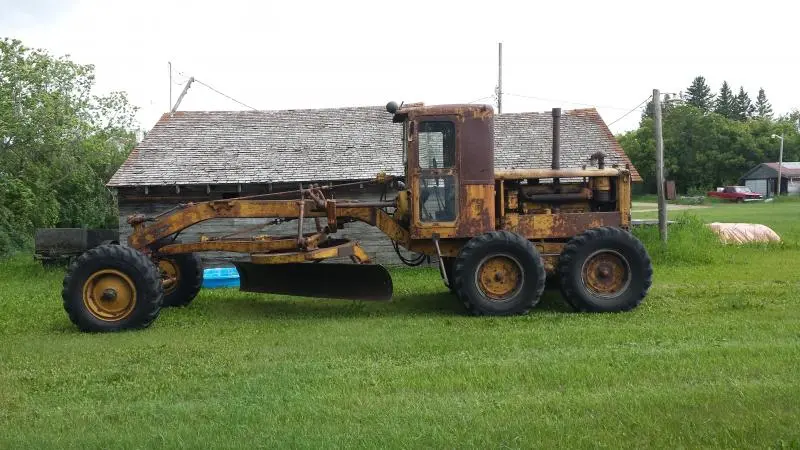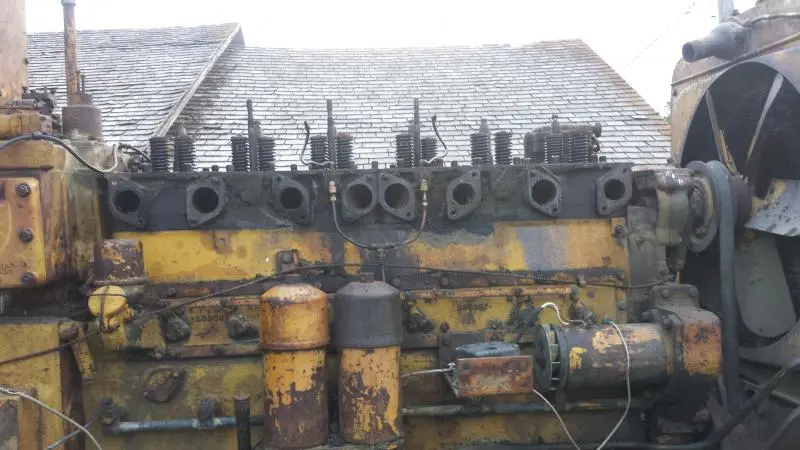9k3585 is a 1941. It has a D4600 6 cyl engine. I am scrapping this one out. Engine is also seized. Some parts I have pulled off of it have been in very good shape and the block has a rebuild tag on it. Keep thinking I need to pull the heads to see if I have a good engine. From what I read, parts are getting scarce for the D4600. The chain boxes and lift assys are very similar to later machines 1949-1956. Transmission is very different than later machines.Pony motor is similar with a different exhaust set up. This pony had 1/8 play in the rods. You have an old one for sure. Hope this helps.
Hello,
Your 9K #12 grader is also a 1941. catskinner
You have a wonderful day. Best wishes. Deas Plant.
Hi, Pushin daisies.
Congratulations on becoming the proud(?) owner of a Cat #12 grader. It is amazing what problems can be fixed relatively cheaply on these old ladies but then sometimes an apparently very simple thing will cost an arm, a leg and a pint of blood.
I would suggest that the first thing you need to do is find out how the antifreeze got into the oil and look at what you need to do to stop that from happening. That may well involve removing the head. If so, that would give you a probably not very clean shot at seeing what is causing the seizure.
It may also be that there is a crack somewhere in the water jacket or the head. If so, this link may help:
http://castingrepair.locknstitch.com/viewitems/lock-kits-2/lock-kits/
And here is a discussion about cast iron weld repairs, including some mention of the 'locknstitch' method.
https://www.practicalmachinist.com/vb/general-archive/lock-n-stitch-82418/
Until you start getting into fuel and injector pumps, etc., there isn't a whole lot that will fly off into the thickest patch of grass it can find.
You may also find something useful here:
http://www.acmoc.org/bb/showthread.php?20409-Cat-12-Graders-Pre-G-series
You will find a zerk - or the place where one should be - at pretty much EVERY pivot point, including under the floor on the clutch, brake, accelerator and gear shift linkages. There will probably also be a zerk on each side under the clamps which hold the rear of the main frame to the main axle housings.
There are a goodly number of different gear drive boxes along the various control shafts. ALL of these take gear oil EXCEPT the angle drive box where the lean wheel drive shaft turns down from the front of the main frame toward the front axle. That one is lubricated by grease pumped into the various zerks on the box.
Hope this helps.
Just my 0.02.
That kind of project is a can of worms. You better be the type that enjoys a challenge. Man I would be all over that if I had it here.......fun stuff.
I agree, lift off the head, it's heavy and long, so you are going to need mechanical help. Play with how you hook on it to lift it so it comes up straight. A big screwdriver prying in the head gasket space can help get it started. Be careful though, the old service books talk about reusing head gaskets so you might possibly save some coin, but I doubt it. I am 90% sure you can get all the gaskets and seals for it from CAT or aftermarket. Aftermarket is probably going to be a little thin on coverage just because of the age of the machine.
It's just an engine, a big one to me and you, but just an engine that was made to be disassembled and overhauled, not thrown away.
That being said, a good running engine , if such were available to you, would be cheaper in the long run. The problems with good runners is they are absolutely an unknown quantity, "pig in a poke" type deal. You need to see them running in an operating machine or test stand before you should assume it will run and do the job.
So you're back to fixing yours most likely. Take special care to cover all fuel system openings as you remove things. Aluminum foil works good if you don't have plastic caps. I'm talking lots of layers smushed down over the open nipple and crushed so it stays there. Beware hanging injection pipes up on a clean board etc. My shop has an infestation of mud dauber wasps just waiting for something like that. A week and they'll have all the openings plugged!
I'm betting on a leaking precombustion chamber seal, pitted through PC chamber etc, that would put water in one cylinder and then it seeps down past the rings and fills the crankcase, floating the oil up....or maybe it just got filled up with rain water through open exhaust valves. You'll know more when you get the head off and see what's wet, what's dry, what's rusty, what's still covered in carbon etc.
Block that loader boom up and hang a come along hand hoist under it so you have good control lifting off and more importantly setting head back down when reinstalling. I have dealt with the D318 heads that would be similar in size and weight. The D318 replaced the D4600 in 1948.
Two men can remove and replace a head by hand with the proper lifting hand holds etc, that's how we did it, but we also crushed several brass ferrules trying to set it down until we found and filed/stoned off a ding on the corner of the head that was throwing us off as we set it down each time. With a hoist we would have had the control to check what was causing the head to cock each time


Well it showed up this morning looking like a together grader. End of the day the heads are ready to come off. Morning job though. I am most certainly done today. Found a mouse nest in one of the exhaust ports and a whack of surface rust inside the valve covers, rockers.
[attachment=54604]20190703_132925[1].jpg[/attachment][attachment=54605]20190703_205839[1].jpg[/attachment]
Ok so my understanding was that this either has a d4600 or a d318 either way 1 massive head for all 6 cylinders. This engine has 2 separate heads. Did I understand wrong?